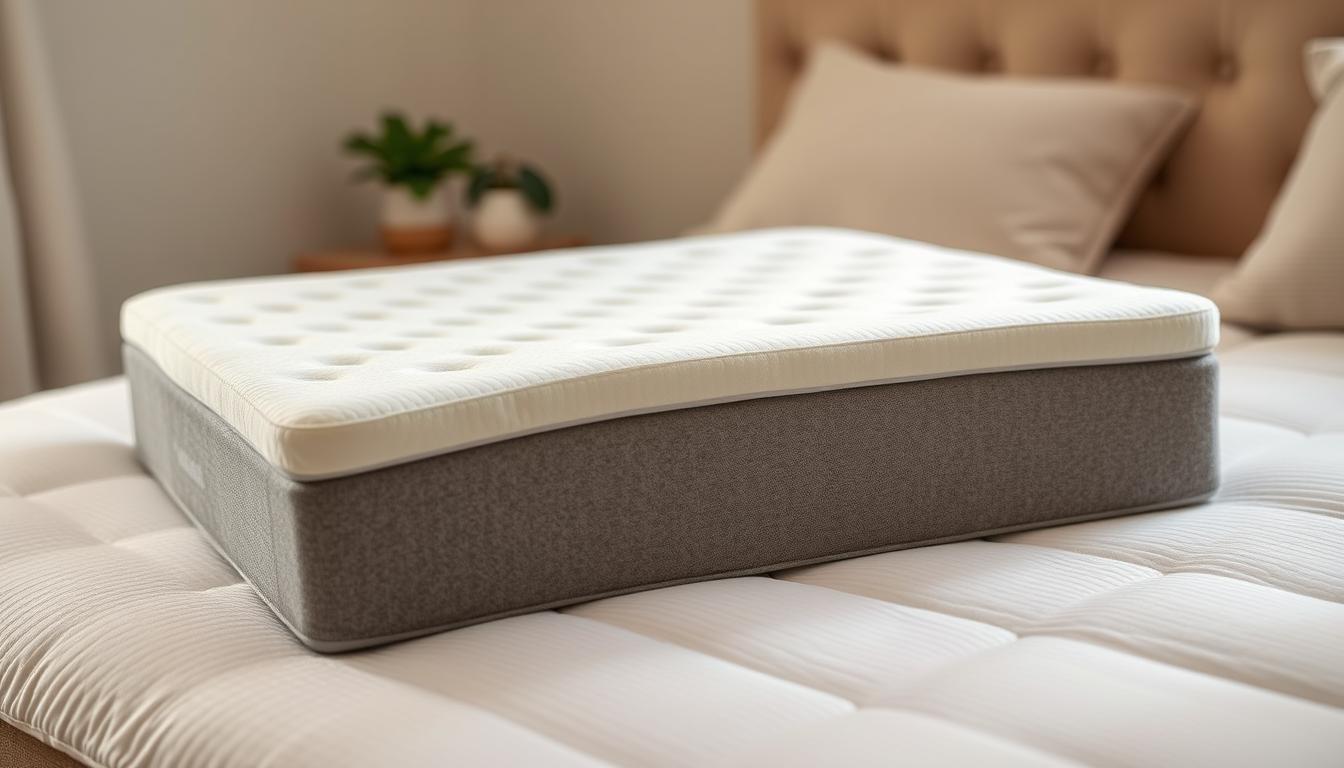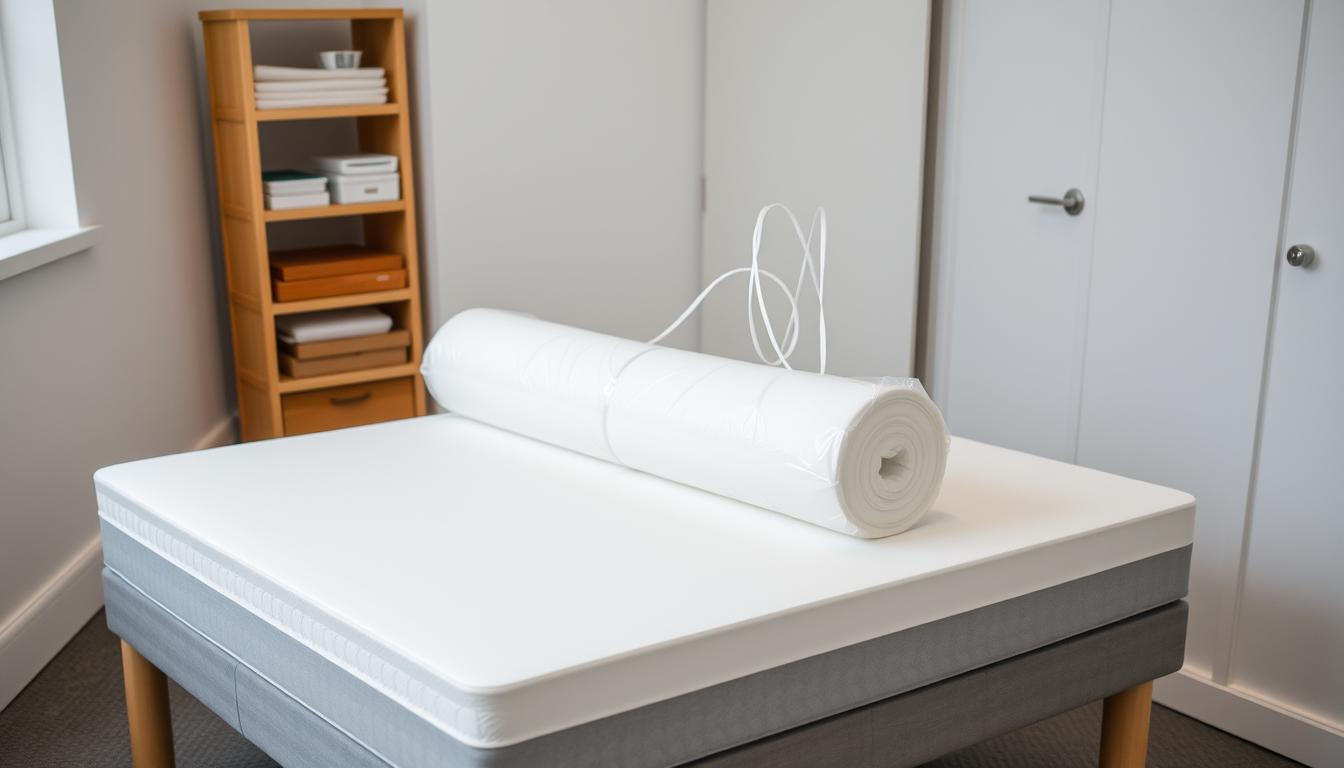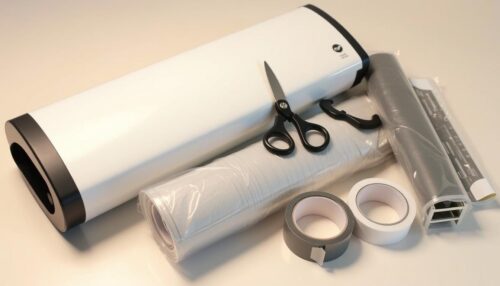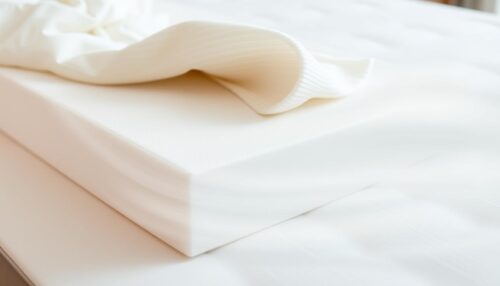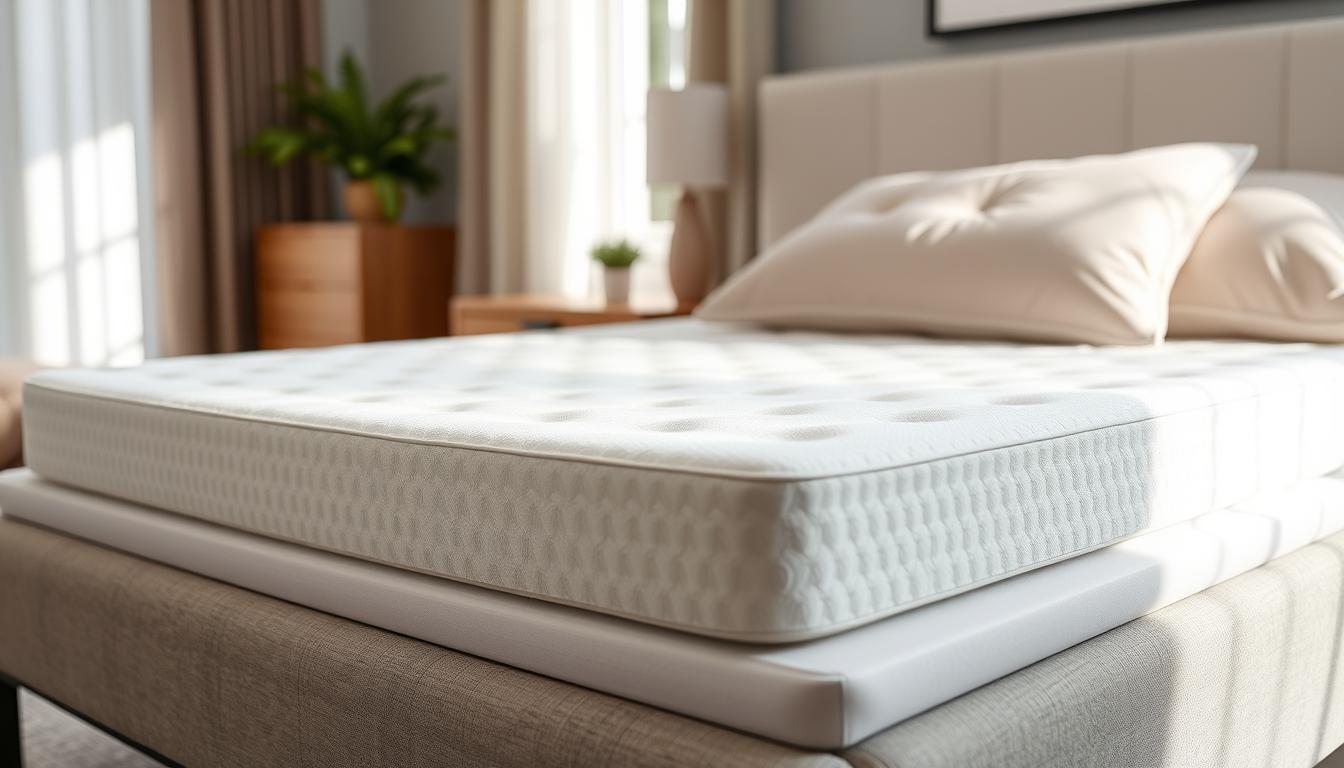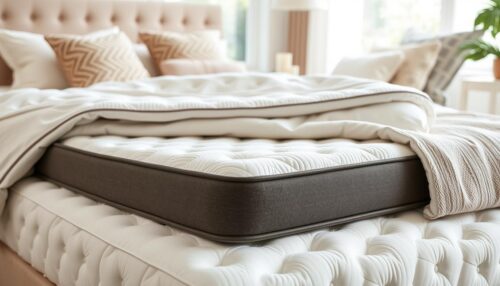Do you wake up with aches and pains? Or feel like your mattress isn’t comfy? A memory foam mattress topper might solve your sleep issues. These additions can make an old mattress feel new again. They offer many benefits that can make sleeping better.
Key Takeaways
- Memory foam mattress toppers can make an old mattress feel new again.
- They help with pressure points, spine alignment, and chronic pain.
- They keep your body temperature right and stop motion from disturbing you.
- Choosing the right thickness and material is key.
- Looking after your topper can make it last longer.
Understanding Memory Foam Mattress Toppers
If you want better memory foam comfort and body contouring, learn about memory foam mattress toppers. These accessories can change your mattress’s comfort and support. They offer a sleep experience that fits your needs.
What is Memory Foam?
Memory foam is a special material for sleepers. It’s a viscoelastic polyurethane foam that shapes to your body. It was introduced in the mid-1990s and is loved for its comfort and support.
How Does Memory Foam Work?
Memory foam works by molding to your body shape. It adjusts to your warmth and pressure, supporting your body. This support helps relax your muscles and align your spine.
| Feature | Benefit |
|---|---|
| Conforming Support | Evenly distributes body weight to reduce pressure points |
| Pressure Relief | Helps alleviate pain and discomfort in problem areas |
| Responsive Design | Molds to your unique body shape for a customized fit |
Learning about memory foam helps you choose a mattress topper. It brings comfort and body contouring to your sleep.
Benefits of Using a Memory Foam Mattress Topper
Getting a memory foam mattress topper can really help your sleep. It adds support and comfort. You’ll sleep better and feel more relaxed.
Enhanced Comfort
Memory foam toppers make your mattress softer. They mold to your body, giving you a soft, cloud-like feel. This makes sleeping more comfortable and relieves pressure points.
Better Support for Your Body
Memory foam fits your body perfectly, supporting it well. It helps keep your spine straight. This is great for people with pain or injuries, as it eases pressure.
Pressure Relief
Memory foam spreads your weight evenly. This reduces pressure on your hips, shoulders, and back. You’ll sleep better and wake up feeling refreshed.
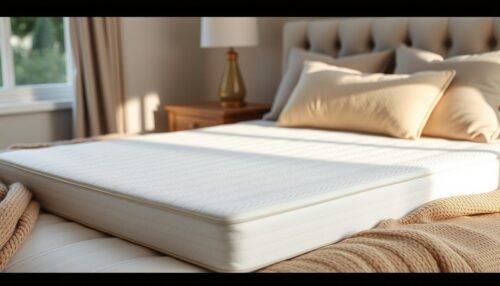
Memory foam toppers also make old mattresses last longer. They make new mattresses feel better when they’re still breaking in. A good memory foam topper means a better night’s sleep and better health.
How a Mattress Topper Affects Sleep Quality
Getting a good memory foam mattress topper can really help your sleep. It supports your body right, making sure your spine is straight. This makes you feel fresh and ready to go in the morning.
Improved Sleep Posture
Memory foam shapes to fit you, giving you support that keeps your spine straight. It also keeps your neck, shoulders, and hips in the right spot. This can make back pain go away, so you sleep better.
Temperature Regulation
Some memory foam toppers have gel or graphite to keep you cool. This is great for people who get too warm while sleeping or sweat a lot at night.
Motion Isolation
Memory foam is really good at stopping movements from spreading. This is a big plus for couples. It means you won’t be bothered by your partner’s movements at night.
A memory foam mattress topper can really improve sleep quality. It helps you wake up feeling more awake and ready to go. Whether you need better temperature control, to stop movements, or just better support, a topper is a smart choice.
Different Types of Memory Foam
Memory foam mattress toppers come in many types. They range from traditional to gel-infused and open-cell designs. Each type has its own benefits. Knowing the differences helps you pick the best topper for better sleep and temperature control.
Traditional vs. Gel-infused Memory Foam
Traditional memory foam molds to your body for great pressure relief. But, it can get hot, making you warmer. To fix this, gel-infused memory foam toppers have tiny gel beads. These beads help keep you cool and comfortable.
Open-cell vs. Closed-cell Foam
Memory foam toppers also differ in their cell structure. Open-cell memory foam is more breathable, letting air in and heat out. On the other hand, closed-cell memory foam traps heat but offers more support and lasts longer.
| Memory Foam Topper Type | Price Range | Thickness Options | Key Benefits |
|---|---|---|---|
| Linenspa Gel Swirl Memory Foam | $97 – $160 | 2″, 3″, 4″ | Cooling gel infusion, nearly 20,000 5-star reviews |
| ViscoSoft Memory Foam | $144 – $200 | 2″, 3″, 4″ | Contouring support, temperature regulation |
| Tuft & Needle Foam | $161 – $189 | 2″ | Targeted zoned support, pressure relief |
| Nolah Mattress Topper | $349 | 2″ | Cushioning and support zones for comfort |
| Lift by Amerisleep | $322 | Not specified | Targeted zoned support, temperature regulation |
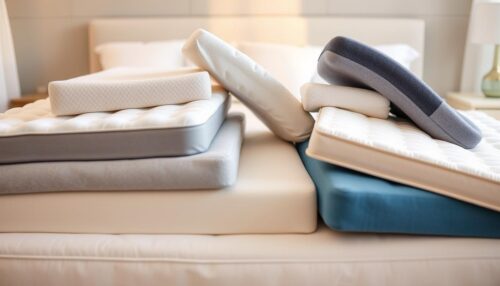
When picking a memory foam topper, think about what you need. Consider your sleep style, budget, and what’s important to you. With so many choices, you’ll find the perfect topper to improve your sleep.
What to Consider Before Buying a Mattress Topper
A memory foam mattress topper can really change your sleep game. But, before you buy, think about a few important things. This will help you pick the best one for you.
Thickness and Density
The topper’s thickness matters a lot. Memory foam toppers are usually 1 to 4 inches thick. A 2-3 inch topper gives more memory foam comfort and pressure relief.
The foam’s density also matters. Higher-density foams last longer and support better.
Firmness Level
The topper’s firmness is key to its feel and support. If you like it soft, a 3-inch foam or feather topper is good. For more support, a firmer 1.5-2 inch mattress topper advantages is better.
Budget Considerations
Mattress toppers vary in price. Think about your budget. A higher-quality topper might cost more but last longer and feel better.
Choosing the right topper is personal. Think about what you need for a good night’s sleep. The right topper can make a big difference.
How to Properly Care for Your Mattress Topper
Getting a good memory foam mattress topper can really help your sleep. But, you need to take care of it to make it last. Here are some tips to keep your topper in great shape.
Cleaning Tips
When cleaning your memory foam mattress topper, be gentle. Always follow what the maker says. Don’t soak it or use strong cleaners, as they can hurt it. Instead, clean spots with a soft soap and water.
For hard stains like blood or sweat, use a special cleaner. These cleaners break down stains without harming the foam. Vacuuming it once a month also helps get rid of dust mites and allergens.
Maintenance Best Practices
- Turn and flip the topper every six months to make it last longer.
- Use a mattress cover to stop stains and smells from getting in.
- Keep the topper in a vacuum-sealed bag when not using it to keep it clean.
- Change the topper every 3-4 years, or sooner if it’s worn out.
By following these easy mattress topper care and memory foam maintenance tips, your topper will last longer. You’ll sleep better and more comfortably for years.
How Long Can You Expect Your Mattress Topper to Last?
Thinking about how long your mattress topper will last is important. The life of a memory foam mattress topper depends on its quality and how well you take care of it. High-density memory foam toppers usually last 3 to 5 years. But, lower-density ones might not last as long.
Organic latex mattress toppers, though, can last up to 25 years if you take good care of them.
Lifespan of Different Types
- Feather/Down Topper: 1-2 years
- Memory Foam Topper: 2-5 years
- Latex Topper: 5-15 years
- Wool Topper: Up to 10 years
The average life of a memory foam mattress topper is about 3 years. But, this can change based on how often you use it, how well you care for it, and its quality. Better memory foam toppers usually last longer than cheaper ones.
Signs It’s Time to Replace
As your memory foam mattress topper gets older, you might see signs it’s time for a new one. Look for sagging, loss of support, and strong odors. If you wake up with aches or the topper doesn’t feel right anymore, it’s time for a new one.
Keeping your memory foam mattress topper in good shape can make it last longer. Make sure to air it out, use a protector, and clean and rotate it when needed. Taking care of your topper means you’ll get to enjoy a comfy, supportive sleep for many years.
Where to Buy a Memory Foam Mattress Topper
Looking for a memory foam mattress topper? You can buy online or in a store. Each way has its own benefits, so think about what you like best.
Online vs. In-store Shopping
Buying online gives you more choices and often lower prices. Sites like Softbedroom.com have lots of info, reviews, and even virtual try-ons. But, shopping in stores lets you touch and try before you buy, which some people like better.
Popular Brands to Consider
Top brands for memory foam mattress toppers include Tempur-Pedic, Saatva, and Lucid. They’re known for quality, great service, and long warranties. Look at different mattress topper brands to find the best one for you.
| Brand | Trial Period | Warranty | Shipping |
|---|---|---|---|
| Tempur-Pedic | 90 days | 10 years | Standard Shipping: Most products ship via FedEx®. In-home delivery available for an additional fee per order, with delivery windows scheduled within a 4-hour time frame. |
| Saatva | 180 days | 15 years | Standard Shipping: Most products ship via FedEx®. In-home delivery available for an additional fee per order, with delivery windows scheduled within a 4-hour time frame. |
| Lucid | 30 days | 3 years | Standard Shipping: Most products ship via FedEx®. In-home delivery available for an additional fee per order, with delivery windows scheduled within a 4-hour time frame. |
When you buy memory foam topper, look for brands with good trials and warranties. The right mattress topper brands will give you comfort and support for years.
Conclusion: Is a Memory Foam Mattress Topper Right for You?
Getting a memory foam mattress topper can really change your sleep game. It’s a great way to boost your sleep without buying a new mattress. Whether it’s right for you depends on what you like to sleep on and your budget.
Personal Sleep Preferences
If you want more comfort and support, a memory foam topper is a good pick. They mold to your body, easing pressure and keeping your spine straight. But, if you like a firmer feel or get hot at night, you might prefer latex or wool toppers.
Budget and Lifestyle Considerations
Cost is a big deal when picking a memory foam topper. They’re cheaper than a new mattress but still a big buy. Your lifestyle matters too. If you have kids or pets, a tough latex topper might be better.
Think about what you like, how much you can spend, and your lifestyle. This will help you decide if a memory foam topper is good for you. It can make your sleep better and bring more memory foam benefits.

